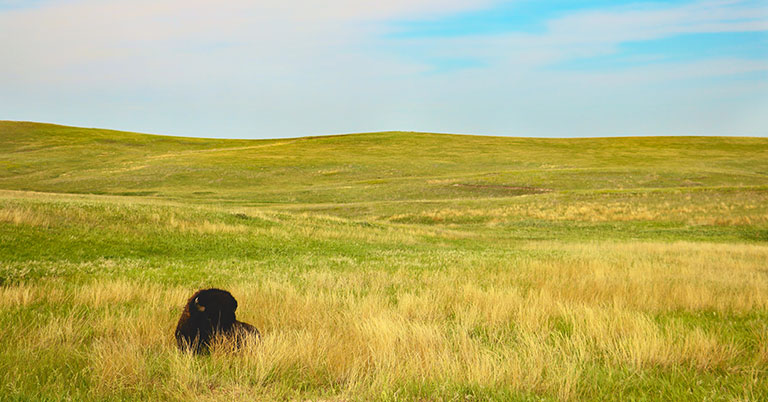
1.6 Million Acres Of Great Plains Grasslands Were Destroyed In 2021
- Thomas Nelson
- October 31, 2023
- Nature, News
- 0 Comments
The disappearance of the Great Plains grasslands has reached a critical point, with an area larger than Delaware being wiped off the map in just one year. This alarming rate of destruction was highlighted in the 2021 World Wildlife Fund’s Plowprint Report, which revealed that 1.6 million acres were converted for agricultural purposes across the United States and Canada, predominantly to accommodate the growth of row crops.
This extensive analysis, based on satellite imagery and government data from the past two years, paints a grim picture of the state of North America’s grasslands. Over the last decade, the region has lost a staggering 32 million acres of its natural landscapes. Interestingly, the World Wildlife Fund notes that the land in the Great Plains most suitable for agriculture was already converted decades ago, meaning that the newly converted land is unlikely to produce significant yields.
The relentless plowing of grasslands is concerning, especially when one considers the vital role they play in carbon sequestration. Clay Bolt, the manager of communications for WWF’s Northern Great Plains program, emphasizes that grasslands act like an underground forest, with intricate root systems that store carbon beneath the soil. When these areas are plowed over for agriculture, the soil is disrupted and this stored carbon is released into the atmosphere. In contrast, the crops that replace the grasslands, such as corn and soybeans, have shallow roots and cannot store as much carbon.
“It’s a devastating loss for these regions, which previously served as natural carbon storage banks,” says Bolt.
Most of the grassland plowing is occurring on private lands, where landowners are making the decision to convert their land for agricultural or commercial development. This has had a detrimental effect on the local ecosystems, as seen in March when the Rockford International Airport began construction through the Bell Bowl Prairie, endangering the habitat of the endangered rusty patched bumblebee in the process.
However, there are areas of grassland that remain protected, such as the Midewin National Tallgrass Prairie in Illinois, which stands as a testament to the potential for conservation. But once grassland is plowed, restoring its ecosystem becomes a mammoth task, if not an impossible one.
Why grasslands are important ecosystems
Grasslands are vital ecosystems that provide a wide array of benefits to both the environment and the human population. These expansive areas of land, dominated by grasses and with few trees or shrubs, are found all around the world, serving as a habitat for numerous species, playing a critical role in maintaining ecological balance, and offering various services essential for human survival.
Biodiversity and Habitat
Grasslands support a diverse range of flora and fauna. They provide habitat for many species of plants, insects, birds, and mammals, some of which are not found anywhere else and many of which are endangered. The vast open spaces and rich plant life offer food and shelter, making grasslands crucial for the survival of these species.
Carbon Sequestration
Grasslands play a significant role in mitigating climate change through their ability to sequester carbon. The plants in grasslands capture carbon dioxide from the atmosphere and store it in their roots and soil. This process helps to reduce the amount of greenhouse gases in the atmosphere, contributing to the stabilization of the climate.
Water Management
Grasslands contribute to water quality and availability. They act like a sponge, absorbing rainwater and slowly releasing it, which helps to maintain water tables and prevent flooding. The plants and soil also filter the water, reducing pollution and improving water quality.
Soil Health
The extensive root systems of grassland plants help to maintain healthy soils. They prevent soil erosion, enhance soil structure, and contribute to nutrient cycling, making the soil more fertile and productive.
Livelihoods and Economy
Grasslands provide livelihoods for millions of people around the world, particularly for pastoralists and farmers. They are important for agriculture, providing grazing land for livestock and space for growing crops. The economic value of grasslands is immense, contributing significantly to the agricultural sector.
Cultural and Recreational Value
Grasslands also have cultural significance for many communities, serving as sites for traditional practices and ceremonies. Additionally, they offer recreational opportunities, drawing visitors for hiking, birdwatching, and other outdoor activities.
Resilience to Climate Change
Grasslands can be more resilient to the impacts of climate change compared to other ecosystems. They can endure extreme weather conditions and adapt to changes in the environment, helping to maintain ecological balance.
Services to Agriculture
Grasslands contribute to the agricultural sector by providing ecosystem services such as pollination, pest control, and nutrient cycling, which are crucial for crop production.
How you can help save grasslands
Saving grasslands is a crucial task that requires collective effort from individuals, communities, governments, and organizations worldwide. Here are several steps you can take to contribute to the conservation and restoration of these vital ecosystems:
1. Support Sustainable Agriculture:
- Choose products from sustainable farming practices that promote the conservation of natural habitats, including grasslands.
- Support local farmers who practice sustainable agriculture, as this helps maintain the health of grasslands and promotes biodiversity.
2. Advocate for Conservation Policies:
- Stay informed about local, national, and international policies affecting grasslands and advocate for their protection.
- Engage with policymakers and encourage them to implement and enforce laws that safeguard grassland ecosystems.
3. Raise Awareness:
- Educate yourself and others about the importance of grasslands and the threats they face.
- Share information through social media, blogs, or community groups to spread awareness and foster a collective sense of responsibility.
4. Contribute to Conservation Organizations:
- Donate to or volunteer with organizations dedicated to grassland conservation and restoration.
- Participate in conservation projects and initiatives that focus on protecting grassland habitats.
5. Practice Responsible Recreation:
- When visiting grassland areas for recreational purposes, stick to designated trails to minimize disturbance to wildlife and plant life.
- Follow “Leave No Trace” principles, ensuring that you take out everything you bring in, and avoid damaging the natural environment.
6. Support Habitat Restoration Projects:
- Get involved in local habitat restoration projects that aim to restore degraded grasslands.
- Participate in tree-planting initiatives, invasive species removal, and other activities that contribute to the health of grassland ecosystems.
7. Promote Sustainable Land Use:
- Encourage sustainable land-use practices that balance development needs with the conservation of grasslands.
- Advocate for the preservation of grasslands in urban planning and development projects.
8. Reduce Your Carbon Footprint:
- Adopt sustainable living practices to reduce your carbon footprint, as climate change is a significant threat to grasslands.
- Use energy-efficient appliances, reduce waste, and opt for renewable energy sources when possible.
9. Encourage Sustainable Grazing Practices:
- Support farmers and pastoralists who employ sustainable grazing practices that help maintain the balance of grassland ecosystems.
- Advocate for policies that promote rotational grazing and other practices that enhance the resilience of grasslands.
10. Participate in Citizen Science:
- Get involved in citizen science projects that contribute to grassland research and monitoring.
- Collect and share data on local grassland conditions, species, and other relevant information to aid conservation efforts.
By taking these actions, you can play a vital role in preserving grasslands, ensuring their survival for future generations, and maintaining the myriad of benefits they provide to both the environment and humanity.

